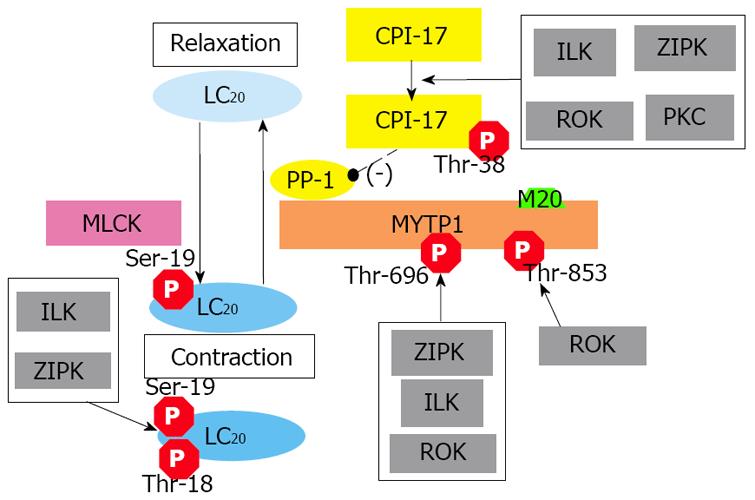Copyright
©2011 Baishideng Publishing Group Co.
World J Gastrointest Pathophysiol. Apr 15, 2011; 2(2): 19-25
Published online Apr 15, 2011. doi: 10.4291/wjgp.v2.i2.19
Published online Apr 15, 2011. doi: 10.4291/wjgp.v2.i2.19
Figure 1 Conventional mechanisms of smooth muscle contraction.
Smooth muscle contraction is primarily governed by the phosphorylation of the regulatory light chain (LC20) of myosin II which is in turn driven by the balance between protein kinases responsible for phosphorylation of LC20 and protein phosphatases responsible for its dephosphorylation. Ca2+ sensitization of contractile force can result from the direct phosphorylation of LC20 by Ca2+-independent protein kinases and/or inhibition of myosin phosphatase activity by Ca2+-independent protein kinases. CPI-17: protein kinase C-potentiated inhibitory protein for protein phosphatase 1 of 17 kDa; ILK: integrin-linked kinase; LC20: 20 kDa myosin light chain; MLCK: myosin light chain kinase; MYPT1: myosin targeting subunit 1 of myosin light chain phosphatase; M20: a 20 kDa non-catalytic subunit of myosin light chain phosphatase; PKC: protein kinase C; PP-1: catalytic subunit of protein phosphatase type-1; ROK: Rho-activated protein kinase; ZIPK: zipper-interacting protein kinase.
- Citation: Ihara E, Akiho H, Nakamura K, Turner SR, MacDonald JA. MAPKs represent novel therapeutic targets for gastrointestinal motility disorders. World J Gastrointest Pathophysiol 2011; 2(2): 19-25
- URL: https://www.wjgnet.com/2150-5330/full/v2/i2/19.htm
- DOI: https://dx.doi.org/10.4291/wjgp.v2.i2.19









